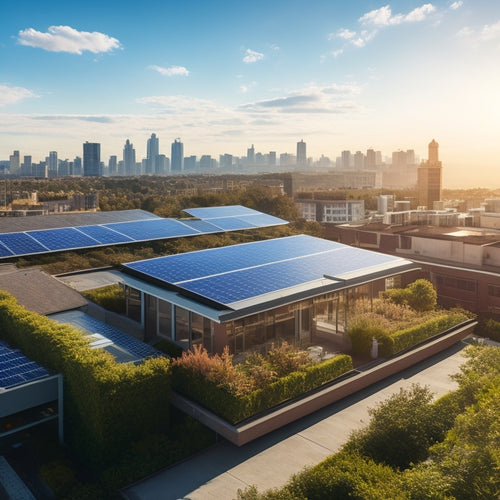
A 10-Step Guide to Connecting Solar Panels to House Wiring
Share
To successfully connect your solar panels to your house wiring, you'll need to prepare your electrical system by verifying its capacity and inspecting wiring materials. Next, choose the right solar panel kit based on your energy requirements and budget, and assess the quality of the panels. Plan the installation, guaranteeing compliance with local building codes and regulations. Install roof mounting hardware, connect the solar panels to inverters, and link the inverters to your electrical panel. Finally, test and inspect the system to confirm it's performing efficiently and safely. As you work through these critical steps, you'll uncover more opportunities to optimize your solar panel system's performance.
Key Takeaways
- Ensure the electrical panel capacity can handle the increased load from solar panels, and consider upgrades if necessary.
- Select a compatible solar panel kit that meets energy requirements and budget constraints, considering off-grid, grid-tie, and hybrid systems.
- Evaluate the quality of solar panels, focusing on efficiency, durability, and warranty terms to minimize risk of premature failure and maintenance costs.
- Verify that the solar panel system complies with local building codes, electrical safety standards, and NEC guidelines for a safe and efficient connection.
- Properly connect solar panels to inverters, and then to the electrical panel, following manufacturer's instructions and ensuring correct wire sizing and connections.
Prepare Your House Electrical System
Before connecting solar panels to your house wiring, verify your electrical system is ready to accommodate the new power source. This involves confirming your electrical panel can handle the additional power and that your wiring materials meet electrical safety standards.
Check your main electrical panel to see if it has enough capacity to handle the increased load. You may need to upgrade to a larger panel or install a sub-panel specifically for the solar array.
Inspect your wiring materials to make sure they're rated for outdoor use and can withstand the elements. Check for signs of wear, corrosion, or damage, and replace any compromised wiring.
Pay attention to the gauge size, as it affects the flow of electrical current. A larger gauge size can handle more power, but it's crucial to balance this with the increased cost.
Choose the Right Solar Panel Kit
You'll need to select a solar panel kit that suits your energy requirements and budget.
There are different kit types available, including grid-tie, off-grid, and hybrid systems, each with its own set of components and installation requirements.
When choosing a kit, you'll want to evaluate the quality of the solar panels, including their efficiency, durability, and warranty.
Kit Types Available
Several solar panel kits are available on the market, each designed to cater to specific needs and applications. As you browse through the options, you'll come across various solar panel types and portable solar kits that can be customized to your energy requirements.
-
Off-Grid Kits: These kits are ideal for remote locations or areas with unreliable grid connections. They typically include a battery bank, inverter, and charge controller, allowing you to store excess energy for later use.
-
Grid-Tie Kits: Designed for homes already connected to the grid, these kits allow you to generate your own electricity and feed any excess back into the grid. They usually include an inverter and monitoring system.
-
Hybrid Kits: Offering the best of both worlds, hybrid kits combine off-grid and grid-tie capabilities, providing a reliable and efficient energy solution for homes with varying energy needs.
When choosing a kit, consider factors such as your energy requirements, available space, and budget.
Solar Panel Quality
Now that you've selected a kit type suited to your energy needs, it's time to focus on the heart of your solar panel system: the solar panels themselves. The quality of your solar panels will greatly affect your system's performance and overall return on investment.
When evaluating solar panel quality, you'll want to take into account two vital factors: solar panel efficiency and solar panel lifespan.
Solar panel efficiency refers to the amount of sunlight that's converted into usable electricity. Look for panels with high efficiencies (above 20%) to maximize energy production. A higher-efficiency panel will generate more power per hour of sunlight, making it a worthwhile investment.
Solar panel lifespan is equally important. A longer-lasting panel means fewer replacements and maintenance costs over the system's lifetime. Look for panels with warranties that guarantee a certain level of performance for 25 years or more.
A high-quality solar panel will provide consistent energy production and minimize the risk of premature failure. By choosing a reputable brand with a proven track record, you'll guarantee a reliable and efficient solar panel system that meets your energy needs.
Plan the Solar Panel Installation
You'll need to determine your solar panel requirements, including the number of panels and their wattage, to guarantee you're generating enough power to meet your energy needs.
When sizing your system, consider factors like your energy usage, roof size and orientation, and local solar irradiance.
Additionally, you must comply with local building codes and regulations, which may specify requirements for installation, inspection, and connection to the grid.
Solar Panel Requirements
What kind of solar panel system do you need to power your house? The type and size of your solar panel system depend on your energy requirements, budget, and available roof space.
To determine your solar panel requirements, consider the following factors:
-
Energy conversion efficiency: Look for solar panels with high energy conversion efficiency to maximize energy output per unit area.
-
Solar panel types: Choose from monocrystalline, polycrystalline, or thin-film solar panels, each with its own advantages and disadvantages.
-
System size and configuration: Decide on the number of solar panels, their wattage, and configuration to guarantee ideal energy production.
When selecting your solar panel system, verify it's compatible with your house wiring and meets local building codes and regulations.
It's crucial to assess your energy needs and choose a system that can provide the required power output. By considering these factors, you can select a suitable solar panel system that meets your energy requirements and budget.
System Sizing Considerations
A crucial aspect of planning a solar panel installation is determining the best system size, which involves calculating the number of panels required to meet your energy needs.
To do this, you'll need to evaluate your energy usage and identify areas for improvement. Start by analyzing your past electricity bills to determine your average daily energy consumption. You should also take into account your energy efficiency goals and the available roof space for the solar panels.
When selecting a system size, you'll want to guarantee it's optimized for solar energy efficiency. A larger system may not always be the best option, as it may not be fully employed during periods of low energy demand.
Additionally, you'll need to take into account grid connection options, such as whether you want to connect to the grid or maintain an off-grid system.
Local Building Codes
Three key considerations come into play when planning your solar panel installation: local building codes, permits, and inspections.
As you maneuver through the permitting process, it's vital to understand the local building codes that govern your project. Failure to comply can lead to costly compliance issues and even project delays.
-
Electrical Codes: Confirm your solar panel installation meets the National Electric Code (NEC) standards, which provide guidelines for safe electrical installations.
-
Building Codes: Familiarize yourself with local building codes, such as the International Building Code (IBC) or the International Residential Code (IRC), which cover aspects like roof structural integrity and fire safety.
-
Zoning Regulations: Verify that your solar panel installation complies with local zoning regulations, including setback requirements and neighborhood covenants.
Install Roof Mounting Hardware
Your roof's trusses, typically spaced 16 or 24 inches on-center, will provide the anchoring points for the solar panel array's roof mounting hardware.
You'll need to select hardware that's compatible with your roof type, whether it's asphalt shingle, metal, tile, or another material. Confirm the hardware materials are durable and corrosion-resistant, as they'll be exposed to the elements.
For a secure installation, you'll use a combination of flashing, brackets, and clamps. Flashing will seal the penetration points where the mounting hardware meets the roof, preventing water ingress.
Brackets will attach the solar panels to the roof, and clamps will hold the panels in place. Verify that the hardware is rated for your local wind and snow loads, and that it meets the requirements of your local building codes.
Properly installing the roof mounting hardware is critical to the safety and performance of your solar panel system.
Take your time, and follow the manufacturer's instructions carefully. Measure twice, and confirm all connections are secure before proceeding to the next step.
Connect Solar Panels to Inverters
With the roof mounting hardware securely in place, you're now ready to connect the solar panels to the inverters. This critical step requires attention to detail to guarantee efficient energy conversion.
You'll need to choose the right inverter type for your system. There are three main types to evaluate:
-
String inverters: Most common type, ideal for small to medium-sized systems.
-
Microinverters: Suitable for systems with multiple panels, offering more flexibility.
-
Power optimizers: A hybrid approach, combining the benefits of string and microinverters.
When selecting an inverter, take into account its efficiency rating, which affects the amount of energy your system produces. Look for inverters with high efficiency ratings (>95%) to maximize your energy output.
Verify the inverter is compatible with your solar panel array's voltage and power output. Properly connecting the solar panels to the inverter will enable efficient energy conversion and peak system performance.
Link Inverters to Electrical Panel
How do you guarantee a seamless changeover of solar-generated power into your home's electrical circuit? You do this by linking your inverters to your electrical panel, securing a safe and efficient transfer of energy.
There are two primary inverter types: string inverters and microinverters. String inverters connect multiple panels in a series, while microinverters connect each panel individually. Regardless of the inverter type, you'll need to connect the output wires to your electrical panel's busbars.
When connecting the wires, prioritize wiring safety. Verify the wires are correctly sized to handle the current output of your inverters. Use the correct gauge wire to prevent overheating and electrical fires.
Additionally, follow the National Electric Code (NEC) guidelines for wire connections and terminations. Connect the wires to the correct phase (A, B, or C) and confirm the wire nuts or connectors are securely fastened.
Properly labeling the wires and connections will also facilitate future maintenance and troubleshooting. By following these guidelines, you'll secure a safe and efficient connection between your inverters and electrical panel.
Test and Inspect the System
The solar panel system is now connected to your house wiring, but it's vital to test and inspect the system to guarantee it's functioning safely and efficiently.
You've invested time and resources into this project, and now it's important to make certain it's performing as expected.
To test the system, you'll need to:
-
Verify system performance: Check the inverter's display or monitoring system to make certain the solar panel system is producing power within the expected range.
-
Conduct safety measures: Inspect the system for any signs of overheating, electrical shock, or fire hazards. Check for loose connections, damaged wires, and proper grounding.
-
Perform a load test: Apply a load to the system to simulate real-world energy usage and verify the system can handle the demand.
Frequently Asked Questions
Can I Connect Solar Panels to My House Wiring Without a Net Meter?
You can connect solar panels to your house wiring without a net meter, but you'll need an off-grid system with battery storage to store excess energy, ensuring a reliable power supply when the grid is down or during nighttime usage.
Do I Need a Permit to Connect Solar Panels to My House Wiring?
You'll typically need a building permit and electrical permit to connect solar panels to your house wiring, which can add $500 to $2,000 to your installation costs, depending on your location and permit types.
How Do I Ensure My Solar Panels Are Compatible With My Electrical System?
As you commence on this eco-friendly expedition, you're wise to guarantee your solar panels harmonize with your electrical system, prioritizing system compatibility and electrical safety; verify your panel's voltage, amperage, and wattage match your home's infrastructure to avoid hazardous mismatches.
Can I Connect Solar Panels to a Septic or Well Water System?
When considering solar panel installation, you'll need to guarantee septic system compatibility; consult with a licensed electrician to determine if your septic system can support the additional electrical load, and investigate specialized equipment designed for off-grid systems.
Will Connecting Solar Panels Void My Home's Electrical Warranty?
When you install solar panels, you're making electrical modifications that might raise concerns about warranty implications. You'll want to review your home's electrical warranty to verify it covers modifications, and consult with the manufacturer or installer to avoid potential warranty voidance.
Conclusion
You've successfully connected your solar panels to your house wiring, integrating renewable energy into your daily life. Now, monitor your system's performance, track your energy savings, and enjoy the benefits of going green. Remember to regularly inspect and maintain your system to guarantee peak operation. With your new solar-powered home, you're reducing your carbon footprint, saving on energy bills, and investing in a sustainable future.
Related Posts
-

What You Need to Know About Permits and Inspections
You need to navigate the complex landscape of permits and inspections to guarantee your project complies with local z...
-

What Is the Cost to Put in Solar Panels
You're likely considering solar panels for your home, and the most significant factor in your decision is the upfront...
-

Safely Staying on Course: 5 Essential Lane Tips
You're about to take your driving skills to the next level by mastering the art of staying in your lane. First, inves...


